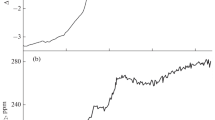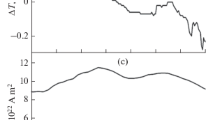Abstract
The heliospheric modulation potential is reconstructed for the period from 12 000 to 8000 BC based on the content of the cosmogenic isotope 10Be in layers of the GISP2 ice core of the Greenland Ice Sheet. The results are compared with the heliospheric modulation potential reconstructed earlier from radiocarbon data and with data on climate change. In particular, we show that the cooling during the Younger Dryas (~10 700–9700 BC) may have caused by low solar activity. Two periods of high solar activity are distinguished at the early Holocene, near 9600–9400 and 8900–8400 BC, which indicates the possible effect of variations in the solar activity on the Earth’s climate change.



Similar content being viewed by others
REFERENCES
Cuffey, K.M. and Clow, G.D., Temperature, accumulation, and ice sheet elevation in central Greenland through the last deglacial transition, J. Geophys. Res.: Oceans, 1997, vol. 102, no. C12, pp. 16 383–26 396.
Cuffey, K.M., Clow, G.D., Alley, R.B., Stuiver, M., Waddington, E.D., and Saltus, R.W., Large Arctic temperature change at the Wisconsin-Holocene glacial transition, Science, 1995, vol. 270, pp. 455–458.
Finkel, R.C. and Nishiizumi, K.J., Beryllium 10 concentration in the Greenland Ice Sheet project 2 ice core from 3–40 ka, J. Geophys. Res.: Oceans, 1997, vol. 102, no. C12, pp. 26699–26707.
Knudsen, M.F., Riisager, P., Donadini, F., et al., Variations in the geomagnetic dipole moment during the Holocene and the past 50 kyr, Earth Planet. Sci. Lett., 2008, vol. 272, pp. 319–329.
Kovaltsov, G.A., Mishev, A., and Usoskin, I.G., A new model of cosmogenic production of radiocarbon 14C in the atmosphere, Earth Planet. Sci. Lett., 2012, vol. 337, pp. 114–120.
Kudryavtsev, I.V., Reconstruction of heliospheric modulation potential based on data on the content of the cosmogenic isotope 10Be in Greenland ice and the extremes of solar activity from the end the 14th century, Geomagn. Aeron. (Engl. Transl.), 2020, vol. 60, no. 8, pp. 1028–1031.
Kudryavtsev, I.V. and Dergachev, V.A., Reconstruction of heliospheric modulation potential based on radiocarbon data in the time interval 17 000–5000 year B.C., Geomagn. Aeron. (Engl. Transl.), 2019, vol. 59, no. 8, pp. 1099–1102.
Kudryavtsev, I.V. and Jungner, H., A possible mechanism of the effect of cosmic rays on the formation of cloudiness at low altitudes, Geomagn. Aeron. (Engl. Transl.), 2005, vol. 45, no. 5, pp. 641–648.
Kudryavtsev, I.V. and Jungner, H., Variations in atmospheric transparency under the action of galactic cosmic rays as a possible cause of their affect on the formation of cloudiness, Geomagn. Aeron. (Engl. Transl.), 2011, vol. 51, no. 5, pp. 656–663.
Kudryavtsev, I.V., Dergachev, V.A., Kuleshova, A.I., Nagovitsyn, Yu.A., and Ogurtsov, M.G., Reconstructions of the heliospheric modulation potential and Wolf numbers based on the content of the 14C isotope in tree rings during the Maunder and Spörer minimums, Geomagn. Aeron. (Engl. Transl.), 2016, vol. 56, no. 8, pp. 998–1005.
Larsen, N.K., Levy, L.B., Carlson, A.E., Buizert, C., Olsen, J., Strunk, A., Bjørk, A.A., and Skov, D.S., Instability of the northeast Greenland ice stream over the last 45,000 years, Nat. Commun., 2018, vol. 9, id 1872.
Marcott, S.A. and Shakun, J.D., Holocene climate change and its context for the future, Pages Mag., 2015, vol. 23, no. 1, p. 28.
Marsh, N. and Svensmark, H., Cosmic rays, clouds and climate, Space Sci. Rev., 2000a, vol. 94, pp. 215–230.
Marsh, N.D. and Svensmark, H., Low cloud properties influenced by cosmic rays, Phys. Rev. Lett., 2000b, vol. 85, no. 23, pp. 5004–5007.
Marsh, N. and Svensmark, H., Solar influence on Earth’s climate, Space Sci. Rev., 2003, vol. 107, pp. 317–325.
Muscheler, R., Adolphi, F., and Nilsson, A., The revised sunspot record in comparison to cosmogenic radionuclide-based solar activity reconstructions, Sol. Phys., 2016, vol. 291, pp. 3025–3043.
Ogurtsov, M.G., Long-term solar cycles according to data on the cosmogenic beryllium concentration in ice of central Greenland, Geomagn. Aeron. (Engl. Transl.), 2010, vol. 50, no. 4, pp. 500–506.
Ogurtsov, M.G., Solar activity during the Maunder Minimum: Comparison with the Dalton Minimum, Astron. Lett., 2018, vol. 44, pp. 278–288.
Poluianov, S.V., Kovaltsov, G.A., Mishev, A.L., and Usoskin, I.G., Production of cosmogenic isotopes 7Be, 10Be, 14C, 22Na, and 36Cl in the atmosphere: Altitudinal profiles of yield functions, J. Geophys. Res.: Atmos., 2016, vol. 121, pp. 8125–8136.
Reimer, P.J., Bard, E., Bayliss, A., et al., IntCal13 and MARINE13 radiocarbon age calibration curves 0–50 000 years calBP, Radiocarbon, 2013, vol. 55, no. 4, pp. 1869–1887.
Shakun, J.D., Clark, P.U., He, F., Marcott, S.A., Mix, A.C., Liu, Z., Otto-Bliesner, B., Schmittner, A., and Bard, E., Global warming preceded by increasing carbon dioxide concentrations during the last deglaciation, Nature, 2012, vol. 484, pp. 49–55.
Svensson, A., Andersen, K.K., Bigler, M., et al., A 60 000 year Greenland stratigraphic ice core chronology, Clim. Past, 2008, vol. 4, pp. 47–57.
Tinsley, A.B., Influence of solar wind on global electric circuit and inferred effects on cloud microphysics, temperature and dynamics in the troposphere, Space Sci. Rev., 2000, vol. 94, pp. 231–258.
Vieira, L.E.A., Solanki, S.K., Krivova, N.A., and Usoskin, I., Evolution of the solar irradiance during the Holocene, Astron. Astrophys., 2011, vol. 531, no. A6, pp. 1–20.
Funding
The work was partly supported by the Russian Foundation for Basic Research (project nos. 18-02-00583 and 19-02-00088).
Author information
Authors and Affiliations
Corresponding authors
Ethics declarations
The authors declare that they have no conflicts of interest.
Additional information
Translated by O. Ponomareva
Rights and permissions
About this article
Cite this article
Kudryavtsev, I.V., Dergachev, V.A. Solar Activity and Climate Change at the End of the Ice Age and Transition to the Holocene. Geomagn. Aeron. 61, 1057–1062 (2021). https://doi.org/10.1134/S0016793221070124
Received:
Revised:
Accepted:
Published:
Issue Date:
DOI: https://doi.org/10.1134/S0016793221070124




